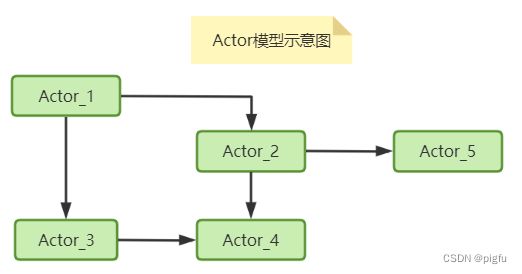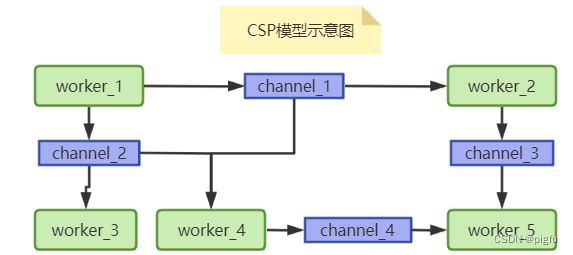go channel实践与源码探索(初始化、发送消息、接收消息、关闭)
文章目录
-
- 概要
- 一、并发编程
-
-
- 1.1、Actor模型
- 1.2、CSP模型
-
- 二、Go Channel实践
- 三、源码分析
-
-
- 3.1、初始化
- 3.2、发送消息
- 3.3、接收消息
- 3.4、关闭通道
-
- 总结
概要
通道(Channel)是Go语言提供的协程之间通信与同步的方式。我们知道在并发编程(多进程、多线程)中,进程or线程间的通信和同步是基础,不然就无法解决五位哲学家就餐之类的问题,但是传统的通信同步方式太过复杂,需要开发者了解互斥锁、临界区管理、条件变量控制等,这些东西在Go语言中Channel都帮你做了(屏蔽了),简而言之,你可以放心大胆的用channel去进行不同Goroutine之间的通信与同步,来完成对Goroutine的竞争关系,协作关系的实现。
Go语言是遵循CSP编程模型的,其核心是通过通道来实现通信与同步。在Go语言中借助其调度器,可以高效的实现通道的阻塞与唤醒,进而实现通道的多路复用(Select 操作)。因此Go的并发编程强调不要利用共享内存来进行Goroutine通讯,而应该依靠通讯来共享数据(Do not communicate by sharing memory; instead, share memory by communicating),尽量避免锁和协程争用。
PS:go V1.20.6
一、并发编程
在聊Go channel之前,这里先问一句,Go Channel是用来干什么的?其实在摘要中已经说了,处理并发下多个Goroutine之间的竞争与协作关系,进程线程在并发中同样面临该问题。
进程间通信在学习操作系统一书中就了解到,同一服务器内的进程之间主要有五种:信号、管道、消息传递、信号量、共享内存(当然了,不同服务器进程之间通过网络,比如TCP,本文只聊同一服务器)。
线程之间主要是共享内存+锁、消息传递等。
消息传递和共享内存模式是使用比较广泛的,其中消息传递在实践中主要分为Actor和CSP两种模型,Actor模型重点在于参与交流的实体,而CSP模型重点在于交流的通道。
1.1、Actor模型

Actor模型首先是由Carl Hewitt在1973年提出定义, 随后由Erlang OTP (Open Telecom Platform) 推广开来。Actor属于并发组件模型, 通过组件方式定义并发编程范式的高级原语,避免使开发者直接接触多线程并发或线程池等基础概念,其消息传递更加符合面向对象的原始意图。
传统多数流行的语言并发是基于多线程之间的共享内存,使用同步机制(互斥锁)来防止写竞争。而在Actor消息模型中,每个Actor在任何时间都是串行执行的,即同一时间处理最多一个消息,最多可以发送一个消息给其他Actor,保证了单独写原则,从而巧妙避免了多线程的写竞争。
在Actor模型中,主角是Actor,类似Go语言中的goroutine,Actor彼此之间可以直接发送消息,不需要经过中介,消息是异步发送和处理的。
每个 Actor 可以认为是一个基本的计算单元,它能接收消息并基于其进行运算,也可以发送消息给其他 Actor。Actor之间相互隔离,它们之间并不共享内存。
Actor 是由状态(State)、行为(Behavior)和邮箱(MailBox,可以认为是一个消息队列)三部分组成:
- 状态:Actor 中的状态指 Actor 对象的变量信息,状态由 Actor 自己管理,避免了并发环境下的锁和内存原子性等问题;
- 行为:Actor 中的计算逻辑,通过 Actor 接收到的消息来改变 Actor 的状态;
- 邮箱:邮箱是 Actor 和 Actor 之间的通信桥梁,邮箱内部通过 FIFO消息队列来存储发送方 Actor 消息,接受方 Actor 从邮箱队列中获取消息。
除了Erlang语言,目前akka库是比较流行的Actor并发编程模型的实现,支持Scala和Java语言
1.2、CSP模型

CSP(Communicating Sequential Processes)是由Tony Hoare在1978的论文上首次提出的。 它是处理并发编程的一种设计模式或者模型,指导并发程序的设计,提供了一种并发程序可实践的组织方法或者设计范式。通过此方法,可以减少并发程序引入的其它缺点,减少和规避并发程序的常见缺点和bug,并且可以被数学理论所论证。
CSP将程序分成两种模块,Processor 与 命名Channel:
- Processor 代表了执行任务的顺序单元,它们内部没有并发;
- Channel代表了并发流之间的信息交互,如共享数据的交换、修改、消息传递,状态同步等等。
除了Channel,Processor之间再无联系,这样就将并发同步作用转移至Channel,使得问题得到了约束、集中。同步操作与竞争操作并没有消失,只是聚焦于Channel之上。Processor之间的协作,由Channel提供并发原语支持,最初Channel是无缓冲的,因此发送操作会阻塞,直到接收端接收后才能继续发送,从而提供了一种同步机制。
在CSP模型中,Processor 之间不直接彼此联系,而是通过不同Channel进行消息发布和同步。消息的发送者和接收者之间通过Channel松耦合,发送者不知道自己消息被哪个接收者消费了,接收者也不知道是哪个发送者发送的消息。所以CSP 的好处是使得系统较为清晰,Processor 之间是解耦合的,职责也非常清楚,容易理解和维护。
Go语言的并发编程模型参考了 CSP 理论,其中执行单元Processor对应的是Goroutine, 消息通道Channel对应的就是channel,一起通过后续章节,结合通道(Channel)的使用和原理来体会CSP思想的精髓
二、Go Channel实践
- 初始化
var cname chan int //声明一个chan int 类型的变量,变量名称叫name,默认值为nil
bname := make(chan int)//make函数初始化channel,无缓冲通道
cname = make(chan int,2)//make函数初始化channel,有缓冲通道,缓冲大小为2
注意:一个只声明但未初始化的chan 变量不能进行读,写,关闭、for遍历操作,否则会panic
- 操作
cname<-1 //写入,如果没有缓冲区或缓冲区已满会阻塞
v,ok:=<-cname //读取,如果没有可读数据会阻塞
//或者 v:=<-cname
close(cname)//关闭通道,如果重复关闭会panic
for c:=range cname { //遍历,如果通道没有关闭,在遍历完既有数据后,会一直阻塞
fmt.Println("v:%d,v addr:%p\n", v, &v)
}
for…range是一个语法糖,在遍历通道时,其本质如下:
for{
v,ok := <-ch
if!ok{
break
}
original body
}
- 多路复用select
一个select管理多个channel(类似linux网路操作select,poll,epoll,可以同时管理多个socket)
var dname chan int
select {
case <-cname:
fmt.Println("rand one")
case c:<-cname:
fmt.Println("rand two:", c)
case <-dname: //通过select 读取未声明的chan 是不会panic的
fmt.Println("read nil chan")
case dname<-1: //通过select 写入未声明的chan 是不会panic的,其本质就是占据一次select机会,并不会真的写入数据
fmt.Println("write nil chan")
default:
fmt.Println("rand one")//其他分支都被阻塞时才会被执行
}
很多时候我们并不希望select执行一个分支,就退出,这时可以去for + select
cname<-1
for {
select {//注意,每一次select,如果多个分支的channel都是可读或写的,那么选择哪一个分支完全是随机的
case <-cname:
fmt.Println("rand one")
case <-cname:
fmt.Println("rand two")
}
三、源码分析
go channel的结构体如下:
type hchan struct {
qcount uint // 缓冲区中的元素个数
dataqsiz uint // 缓冲区大小
buf unsafe.Pointer // 缓冲区,一个循环队列(数组)
sendx uint // 队尾,记录发送者在 buf 中索引位置
recvx uint // 队头,记录接收者在 buf 中索引位置
//通道元素相关
elemsize uint16 //元素大小
elemtype *_type // 元素类型
//
closed uint32 //通道关闭标记
recvq waitq // 阻塞的接收者队列 list of recv waiters
sendq waitq // 阻塞的发送者队列 list of send waiters
lock mutex //互斥锁,并发保护。也协助实现channel的同步作用,即当缓冲区耗尽时阻塞接收者或发送者
}
type waitq struct {
first *sudog //记录双向链表的头部
last *sudog //记录双向链表的尾部
}
//其中sudog表示一个在等待链表中goroutine,比如channel中的recvq和sendq。sudog与goroutine是多对1的,如下:
// sudog is necessary because the g ↔ synchronization object relation
// is many-to-many. A g can be on many wait lists, so there may be
// many sudogs for one g; and many gs may be waiting on the same
// synchronization object, so there may be many sudogs for one object.
... 代表代码省略
3.1、初始化
func makechan(t *chantype, size int) *hchan {
elem := t.elem
// compiler checks this but be safe.
if elem.size >= 1<<16 {
throw("makechan: invalid channel element type")
}
if hchanSize%maxAlign != 0 || elem.align > maxAlign {
throw("makechan: bad alignment")
}
mem, overflow := math.MulUintptr(elem.size, uintptr(size))
if overflow || mem > maxAlloc-hchanSize || size < 0 {
panic(plainError("makechan: size out of range"))
}
var c *hchan
switch {
case mem == 0: //当缓冲区设置为0
// Queue or element size is zero.
c = (*hchan)(mallocgc(hchanSize, nil, true))
// Race detector uses this location for synchronization.
c.buf = c.raceaddr()
case elem.ptrdata == 0: //当通道元素非指针
// Elements do not contain pointers.
// Allocate hchan and buf in one call.
c = (*hchan)(mallocgc(hchanSize+mem, nil, true))
c.buf = add(unsafe.Pointer(c), hchanSize)
default: //当通道元素是指针
// Elements contain pointers.
c = new(hchan)
c.buf = mallocgc(mem, elem, true)
}
c.elemsize = uint16(elem.size)
c.elemtype = elem
c.dataqsiz = uint(size)
lockInit(&c.lock, lockRankHchan) //初始化互斥锁
...
return c
}
- 当缓冲区设置为0时,只需申请hchan结构体大小的内存即可;
- 当通道元素非指针时,需要申请hchanSize+mem大小的连续内存,前hchanSize大小用来存储hchan结构体,剩余的用来表示缓冲区;
- 当通道元素是指针时,hchan结构体和缓冲区的内存需要分开申请,因为当元素包含指针时,需要单独申请独立内存才能进行正常的垃圾回收。
3.2、发送消息
func selectnbsend(c *hchan, elem unsafe.Pointer) (selected bool) {
return chansend(c, elem, false, getcallerpc()) //select 方法发送channel消息是非阻塞的
}
func chansend1(c *hchan, elem unsafe.Pointer) {
chansend(c, elem, true, getcallerpc()) //正常的发送channel消息走阻塞逻辑,即没有缓冲区可用时就阻塞当前goroutine
}
func chansend(c *hchan, ep unsafe.Pointer, block bool, callerpc uintptr) bool {
if c == nil {
if !block {
return false//走非阻塞模式,向nil chan发消息,返回false表示不可写
}
gopark(nil, nil, waitReasonChanSendNilChan, traceEvGoStop, 2)//走阻塞模式发消息,就会panic,提示【chan send (nil chan)】
throw("unreachable")
}
if !block && c.closed == 0 && full(c) {
return false //走非阻塞模式,向已关闭或缓冲区耗尽的通道发消息,返回false表示不可写
}
var t0 int64
if blockprofilerate > 0 {
t0 = cputicks()
}
lock(&c.lock) //上锁
if c.closed != 0 {
unlock(&c.lock)
panic(plainError("send on closed channel"))//走阻塞模式,向已关闭的通道发消息,就会panic
}
//下面就是核心了
if sg := c.recvq.dequeue(); sg != nil {//如果接收者队列中有等待读取的goroutine,直接将消息复制给队头协程,并唤醒它
// Found a waiting receiver. We pass the value we want to send
// directly to the receiver, bypassing the channel buffer (if any).
send(c, sg, ep, func() { unlock(&c.lock) }, 3)
return true
}
//如果缓冲区未被耗尽,则将消息放到缓冲区队尾
if c.qcount < c.dataqsiz {
// Space is available in the channel buffer. Enqueue the element to send.
qp := chanbuf(c, c.sendx)
if raceenabled {
racenotify(c, c.sendx, nil)
}
typedmemmove(c.elemtype, qp, ep)
c.sendx++
if c.sendx == c.dataqsiz {
c.sendx = 0
}
c.qcount++
unlock(&c.lock)
return true
}
if !block {//走非阻塞模式,返回false表示不可写
unlock(&c.lock)
return false
}
//如果缓冲区被耗尽,走同步模式,则将当前goroutine放入sudog结构中,并放入发送者队列末尾,最终进入休眠状态等待被唤醒
// Block on the channel. Some receiver will complete our operation for us.
gp := getg()//获取当前协程
mysg := acquireSudog()
mysg.releasetime = 0
if t0 != 0 {
mysg.releasetime = -1
}
// No stack splits between assigning elem and enqueuing mysg
// on gp.waiting where copystack can find it.
mysg.elem = ep
mysg.waitlink = nil
mysg.g = gp //将当前goroutine放入sudog结构中
mysg.isSelect = false
mysg.c = c
gp.waiting = mysg
gp.param = nil
c.sendq.enqueue(mysg)//将sudog放入发送者队列末尾
gp.parkingOnChan.Store(true)
//进行协程切换,去执行别的goroutine,当前goroutine进入休眠状态
gopark(chanparkcommit, unsafe.Pointer(&c.lock), waitReasonChanSend, traceEvGoBlockSend, 2)
//等待被唤醒时继续执行后面的代码
// Ensure the value being sent is kept alive until the
// receiver copies it out. The sudog has a pointer to the
// stack object, but sudogs aren't considered as roots of the
// stack tracer.
KeepAlive(ep)
// someone woke us up.
if mysg != gp.waiting {
throw("G waiting list is corrupted")
}
gp.waiting = nil
gp.activeStackChans = false
closed := !mysg.success//channel被关闭后该字段值会被设为false
gp.param = nil
if mysg.releasetime > 0 {
blockevent(mysg.releasetime-t0, 2)
}
mysg.c = nil
releaseSudog(mysg)
if closed {
if c.closed == 0 {
throw("chansend: spurious wakeup")
}
panic(plainError("send on closed channel"))//在睡眠中,该channel被关闭了,再被唤醒,也会panic,一般不会触发,因为close是会先唤醒等待的读写队列后才会设置closed
}
return true
}
func send(c *hchan, sg *sudog, ep unsafe.Pointer, unlockf func(), skip int) {
...
goready(gp, skip+1) //将sg中的goroutine放到协程的运行队列中,优先放到当前P的本地运行队列,满了在放到全局运行队列,详情见Go GMP
...
}
对源码分析后,可知发送消息分为阻塞模式和非阻塞模式,我们最常用的是阻塞模式,核心逻辑如下:
- 当接收者队列中有等待读取的goroutine时,直接将消息复制给队头协程,并唤醒它。注意这里的唤醒并不是直接切换到队头协程,而是将其放到运行队列中,等待被调度;
- 不满足第一步,且当缓冲区未耗尽时,则将消息写入缓冲区队尾;
- 不满足第二步,且当缓冲区耗尽时,则将当前goroutine放入sudog结构中,并放入发送者队列sendq末尾,进行协程切换,令当前goroutine进入休眠状态等待被唤醒。
3.3、接收消息
func selectnbrecv(elem unsafe.Pointer, c *hchan) (selected, received bool) {
return chanrecv(c, elem, false) //select 方法接收channel消息是非阻塞的
}
func chanrecv1(c *hchan, elem unsafe.Pointer) {
chanrecv(c, elem, true)//正常的接收channel消息走阻塞逻辑,即缓冲区没有消息时就阻塞当前goroutine
}
//参数解析
//c hchan结构体
//ep 接收消息的指针,v <- c,那么ep就是v的指针
func chanrecv(c *hchan, ep unsafe.Pointer, block bool) (selected, received bool) {
if c == nil {
if !block {//走非阻塞模式,向nil chan发消息,返回false表示不可读
return
}
gopark(nil, nil, waitReasonChanReceiveNilChan, traceEvGoStop, 2)//走阻塞模式发消息,就会panic,提示【chan receive (nil chan)】
throw("unreachable")
}
// Fast path: check for failed non-blocking operation without acquiring the lock.
if !block && empty(c) {//非阻塞模式且缓冲区大小为0
if atomic.Load(&c.closed) == 0 {//已关闭的通道直接返回
return
}
// The channel is irreversibly closed. Re-check whether the channel has any pending data
// to receive, which could have arrived between the empty and closed checks above.
// Sequential consistency is also required here, when racing with such a send.
if empty(c) {
// The channel is irreversibly closed and empty.
if raceenabled {
raceacquire(c.raceaddr())
}
if ep != nil {
typedmemclr(c.elemtype, ep)
}
return true, false
}
}
lock(&c.lock)//上锁
if c.closed != 0 {
if c.qcount == 0 {
if raceenabled {
raceacquire(c.raceaddr())
}
unlock(&c.lock)
if ep != nil {
typedmemclr(c.elemtype, ep)
}
return true, false //已关闭且缓冲区没有消息的直接返回,所以一个已关闭的channel也是可以读取消息的,但是已关闭的channel是无法写入消息的。
}
// The channel has been closed, but the channel's buffer have data.
} else {
// Just found waiting sender with not closed.
if sg := c.sendq.dequeue(); sg != nil { //如果发送者队列中有等待写入的goroutine,获取发送者队列中的队头goroutine,直接将其写入的消息复制给当前协程,并唤醒它
recv(c, sg, ep, func() { unlock(&c.lock) }, 3)
return true, true
}
}
if c.qcount > 0 {//如果缓冲区有消息,则直接获取缓冲区队头的消息,并复制到当前的读取协程中
// Receive directly from queue
qp := chanbuf(c, c.recvx)
if raceenabled {
racenotify(c, c.recvx, nil)
}
if ep != nil {
typedmemmove(c.elemtype, ep, qp)//将缓冲区的消息内容复制给承接消息内容的指针
}
typedmemclr(c.elemtype, qp)
c.recvx++
if c.recvx == c.dataqsiz {
c.recvx = 0
}
c.qcount--
unlock(&c.lock)
return true, true
}
if !block {
unlock(&c.lock)
return false, false
}
//如果缓冲区没有消息,走同步模式,则将当前goroutine放入sudog结构中,并放入接收者队列末尾,最终进入休眠状态等待被唤醒
// no sender available: block on this channel.
gp := getg()//获取当前goroutine
mysg := acquireSudog()
mysg.releasetime = 0
if t0 != 0 {
mysg.releasetime = -1
}
// No stack splits between assigning elem and enqueuing mysg
// on gp.waiting where copystack can find it.
mysg.elem = ep
mysg.waitlink = nil
gp.waiting = mysg
mysg.g = gp //将当前goroutine放入sudog结构中
mysg.isSelect = false
mysg.c = c
gp.param = nil
c.recvq.enqueue(mysg)//将sudog放入接收者队尾
// Signal to anyone trying to shrink our stack that we're about
// to park on a channel. The window between when this G's status
// changes and when we set gp.activeStackChans is not safe for
// stack shrinking.
gp.parkingOnChan.Store(true)
//进行协程切换,去执行别的goroutine,当前goroutine进入休眠状态
gopark(chanparkcommit, unsafe.Pointer(&c.lock), waitReasonChanReceive, traceEvGoBlockRecv, 2)
//当协程被唤醒,就继续执行后面的代码
// someone woke us up
if mysg != gp.waiting {
throw("G waiting list is corrupted")
}
gp.waiting = nil
gp.activeStackChans = false
if mysg.releasetime > 0 {
blockevent(mysg.releasetime-t0, 2)
}
success := mysg.success
gp.param = nil
mysg.c = nil
releaseSudog(mysg)
return true, success
}
func recv(c *hchan, sg *sudog, ep unsafe.Pointer, unlockf func(), skip int) {
...
goready(gp, skip+1)//将sg中的goroutine放到协程的运行队列中,优先放到当前P的本地运行队列,满了在放到全局运行队列,详情见Go GMP
}
对源码分析后,可知接收消息分为阻塞模式和非阻塞模式,我们最常用的是阻塞模式,核心逻辑如下:
- 当发送者队列有等待写入的goroutine时,获取发送者队列中的队头goroutine,直接将其写入的消息复制给当前协程,并唤醒它。注意这里的唤醒并不是直接切换到队头goroutine,而是将其放到运行队列中,等待被调度,这样就不会影响当前协程的运行;
- 不满足第一步,且当缓冲区有消息时,则将缓冲区队头消息复制给当前协程;
- 不满足第二步,且当缓冲区满或缓冲区大小为0时,则将当前goroutine放入sudog结构中,并放入接收者队列recvq末尾,进行协程切换,令当前goroutine进入休眠状态等待被唤醒。
3.4、关闭通道
func closechan(c *hchan) {
if c == nil {//关闭未初始化的通道会panic
panic(plainError("close of nil channel"))
}
lock(&c.lock)//上锁
if c.closed != 0 {//重复关闭通道会panic
unlock(&c.lock)
panic(plainError("close of closed channel"))
}
...
c.closed = 1 //设置closed标志位为1
var glist gList
// release all readers
for {
sg := c.recvq.dequeue()
if sg == nil {
break
}
...
gp := sg.g
...
glist.push(gp)//收集所有接收者队列中被阻塞的goroutine
}
// release all writers (they will panic)
for {
sg := c.sendq.dequeue()
if sg == nil {
break
}
...
gp := sg.g
...
glist.push(gp)//收集所有发送者队列中被阻塞的goroutine
}
unlock(&c.lock)
// Ready all Gs now that we've dropped the channel lock.
for !glist.empty() {
gp := glist.pop()
gp.schedlink = 0
goready(gp, 3) //统一唤醒接收者队列和发送者队列中被阻塞的goroutine
}
}
总结
经过第二、三章节的阅读几乎涵盖Go channel的所有知识点了,这里再多说一下chan是否必须close,其实是没必要的,当没有goroutine持有这个chan时其就会被gc回收,并不会泄漏。close最大的作用是唤醒所有接收者队列和发送者队列中被阻塞的goroutine。

